Thursday, December 29, 2005
One Week to Skeptics' Circle
Monday, December 26, 2005
WoW: Cat People

As you might guess from the picture, I spent some time playing with Gullveig, who reached level 20. At this level, she qualifies to learn the Cat form. Alas, learning Cat form is absurdly easy compared to learning Bear form or Aquatic form: you just buy the ability from a trainer. That's something of a let down. I suspect that Blizzard wants learning Cat form to be a quest, but they haven't gotten around to completing it yet. C'est la vie.
Friday, December 23, 2005
Star Wars in 30 Seconds
Skeptics' Circle 24
The next Skeptics' Circle is going to be hosted right here at the Saga on January 5th, so you have a little under two weeks to demonstrate your wit, wisdom, and skepticism in a good blog article and send me a link. You can get more information about the circle, it's history, and what kinds of articles are appropriate by visiting the homepage, Circular Reasoning.
Wednesday, December 21, 2005
Open Letter to NPR
I don't know if NPR will actually air my remarks, so I thought I'd share them with my readers here, as well. I wrote...
With all due respect to the commentator, Joe Loconte has no idea what he's talking about. His comparison of the "Theory" of Intelligent Design to the Big Bang Theory is completely off base. True, the Big Bang Theory did meet with strong opposition when first proposed, but its proponents didn't try to gain acceptance by rail-roading it into high school science classrooms. They defined their theory, stated what it predicted, and then gathered data to either prove or falsify their predictions. They took their research to peer-reviewed scientific journals and let the evidence make their case instead of trying to manipulate an uninformed public into legislating their beliefs. The Big Bang Theory gained the acceptance of the scientific community before it filtered down to high school science classes. The tactics of the ID lobby are nothing like those of real scientists trying to promote a theory. NPR should be exposing the duplicity of the ID movement instead of pandering to them.
Saturday, December 17, 2005
WoW: Gone Swimming

Yes, after travelling all across the World of Warcraft, searching at length along the bottom of the ocean (and drowning a few times in the process), travelling back across the world, and consulting an assortment of characters for directions and such, Gullveig has finally learned how to turn herself into a seal.
Actually, I'm a little bit disappointed by the aquatic form. Seriously, look at the fangs on that beast, and then explain to me why a druid in aquatic form isn't capable of a bite attack! I don't expect the seal form to be able to perform as well as bear or cat form in combat, but it shouldn't be totally incapable of defending itself. Oh, well... complaint isn't likely to get me anywhere.
If you're on the aquatic form quest, you may have trouble figuring out how to find the two pieces of the Aquatic Agility pendant. You have to talk to the flight masters in Moonglade; each gives you directions to a different half of the pendant.
You can get complete details on the quest from the WoWWiki.
Thursday, December 15, 2005
Unexpected But Amusing
Well, I followed one of those links to Ex Cathedra, the weblog of Bob Crispen and family. He's apparently a pretty devout Christian, although religious content doesn't seem to actually dominate his posts. I was curious how someone had found my site from his and was looking for a link to one of my posts within one of his, but I found the actual link in the sidebar. He's got me in his sidebar of blog links under the heading "Heresy".
I guess I'm not in much of a position to deny it, but I wonder what prompted him to categorize me there. There seem to be a lot of anti-ID bloggers under that heading, so I can only guess that he put me there on some kind of creationist impulse. Am I growing beyond "small fry" in the blog pool?
Wednesday, December 14, 2005
Himalayan Salt Crystal Lamps
Our Natural Salt Crystal Lamps and Crystal Rock Salt wellness products will have a profound effect on your health and well-being. You can breathe easier, feel better and live healthier…That’s a pretty significant claim. Fortunately, they have a Health Benefits link that we can follow to get details on how these crystals can improve our lives.
Salt Rock Crystal Lamps create an environment rich in negative ions that has a wonderfully positive effect on your physical, emotional, mental, and even spiritual health.Supposedly our air (especially indoor air) is full of pollutants that carry a positive electrical charge. The Himalayan Rock Crystal is going to “neutralize” these positive ions floating in the air by releasing negative ions. According to the site, this effect is related to another documented treatment.
For many years, people suffering from asthma and other symptoms have gained tremendous relief from underground asthma treatment Speleotherapy, in salt mines, where negative ions are plentiful.Another source -- SaltLamps4U.com -- tries to explain how the ions from salt crystal lamps improve air quality…
Ionizing machines emit negative electric charges into the air, and this supposedly causes airborne allergens to cluster and fall to the ground.Supposedly? They aren't even pretending to have supporting evidence for this claim.
Here’s the problem that I see: one of these lamps is just a hollowed salt crystal with a 15-watt light-bulb inside. How is it supposed to release negative ions? If it’s not getting a steady supply of electrons from somewhere, it can’t be releasing negative ions because it would be giving itself a positive charge that would attract negative ions, thereby defeating itself. Electrical current flowing through that light-bulb is not going to be leaving a surplus of electrons, since the electrons have to keep flowing through the circuit in order to actually work, so where are the electrons coming from? The websites have no explanation, although Natural-Salt-Lamps does try...
…the heated salt crystal attracts the water molecules from the ambient air to its surface. The salt goes into a solution as it mixes with the water molecules. Sodium, as the positively charged ion, and chloride, as a negatively charged ion, becomes neutral and are emitted back into the environment.Yes, salt will dissolve in water, but the positively charged sodium ions and negatively charged chloride ions don’t “become neutral”: they just float around in the solution, which remains neutral overall because it has a balanced number of positive and negative ions in it. The chloride ions won’t magically float out of the solution into the air, because the attraction of the positive sodium ions won’t let them get too far away. You could possibly get both positive and negative ions into the air, but not negative ions alone. In reality, though, you generally get water vaporizing back into the air and leaving the salt behind, and that's exactly the result you should expect with a heated crystal.
Putting aside the physical problems of getting these rock crystals to release ions into the air, we still have to determine whether such ions would be beneficial. According to SaltLamps4U…
It has been researched scientifically that the amount of ions in the environment, that is acceptable by human is ca. 1000-1500/cm3. And normally in closed rooms were electronic appliances are utilized, this amount as low as 200/cm3. So to increase the number of negative ions in the environment, air ionizers are used. These air ionizers generate the negative ions and balance the atmosphere of the room.Naturally, their website doesn't include a reference to these studies. Machines that demonstrably release ions into the air do exist, though, and they’ve been tested. The Division of Respiratory Medicine at University Hospital Basel in Switzerland reviewed studies of alternative asthma treatments conducted since 2002 and published their findings in 2004. PubMed has a summary of their findings:
Studies do not support the use of homeopathy, air ionizers, manual therapy, or acupuncture for asthma. These methods bear some risks to patients related to undertreatment and side effects.Apparently releasing ions into the air has no health benefits, at least not for asthma. So, once again, we have an alternative medicine claim that doesn’t hold up to scientific scrutiny. If you buy a Himalayan Salt Crystal Lamp (or any other kind of salt crystal lamp, for that matter), you’re essentially paying $60 to $100 (or more) for a decorative night light.
If you really want a device to release negative ions into your home atmosphere, though, don’t despair: you probably already have one or more. Contrary to what SaltLamps4U.com says, television sets and computer monitors are negative ion sources (the Cathode Ray Tube inside a TV is specifically designed to spew electrons), and you can see how much effect they have on your air quality. They certainly attract a lot of dust. Assuming that a 15-watt salt lamp has any effect at all, it will be dwarfed by a 40-watt television set, so there's no need to buy a salt lamp, anyway.
EDIT: Eleven years have passed, and this is still one of the most viewed pages on the blog. The remark about having a CRT to spray negative ions into your house probably no longer applies. No evidence that salt lamps have health benefits has surfaced, though.
Monday, December 12, 2005
More About Saltare
I'm not sure what the class schedule is going to look like, yet. I've offered to teach a class, but I'm not sure what I'll teach. I can cover a pretty wide range of dances, so I'd prefer to fill a gap in the schedule, if possible. I do know that Lady Tsire is going to try to attend, and if she can make it she'll be teaching Bouffons.
I'll have to see what I can find out about the class schedule and the ball list.
Thursday, December 08, 2005
Skeptics' Circle 23
WoW: Progress with Druids and Warlocks

Bear form is basically “warrior light” for druids. You get a substantial increase in durability, some special attacks for extra damage, and a few abilities to focus the attention of monsters on your character. Gullveig tends to start a fight with ranged spells like Wrath and Moonfire, cast a heal over time spell as the target approaches, and then switch to bear form as the enemy gets into swinging range.
 She has completed several quests in the Darkshore area, and she’s ready to start a rather complicated quest to acquire her aquatic form. She’ll have to go to Westfall before that quest is complete, so I may be making yet another run through the Deadmines before too long.
She has completed several quests in the Darkshore area, and she’s ready to start a rather complicated quest to acquire her aquatic form. She’ll have to go to Westfall before that quest is complete, so I may be making yet another run through the Deadmines before too long.I also played with Dagran a little bit. He has moved up in pets, relying primarily on a Voidwalker now instead of an Imp. He’s completed all of the Elwynn Forest quests that I know about, and he’s just made the journey into Westfall. I guess that’s actually two more trips to the Deadmines in my future.
I’ve found that a warlock can easily accumulate a vast horde of soul shards without too much effort. Granted, the things are required for various summonings and some other spells, but I do need room in my bags for loot. I’ve got a bunch stashed in the bank, and I try not to accumulate more than one bag of soul shards while questing. Hopefully I’ll be able to get hold of one of the special, high-capacity shard bags before too long.
Tuesday, December 06, 2005
Saltare 2006
The Shire of Tal Mere has put up a website with details.
Friday, December 02, 2005
The Gall of This Guy!
Is he out of his mind? This is the moron who whacked Nancy Kerrigan in the knee with a police baton to try to keep her from competing in the 1994 Winter Olympics. What makes him think that society should just forget that he signed up to be Tonya Harding’s personal knee-capper? I think he should count himself lucky that American law didn’t permit breaking his leg!
"Oh! Woe! The Navy SEALs won’t let me in if I've got a felony criminal conviction!"
Tough, Shane! You should have considered your "dream" of joining the SEALs before becoming a criminal. You don't deserve to be a SEAL, and I don't see why any SEAL would want a treacherous scumbag who tried to cripple an American Olympic athlete at his side when he ventures into enemy territory.
Congratulations to Judge Julie Frantz, who gave him a big "Heck! No!" for an answer.
Wednesday, November 30, 2005
Cthulu by Ego
Tuesday, November 29, 2005
Miracle of the Week
 AP, via Yahoo News, is reporting the latest miracle statue story. Apparently there’s a statue of the Virgin Mary at a church in Sacramento, CA that appears to be crying.
AP, via Yahoo News, is reporting the latest miracle statue story. Apparently there’s a statue of the Virgin Mary at a church in Sacramento, CA that appears to be crying.It was first noticed more than a week ago, when a priest at the Vietnamese Catholic Martyrs Church spotted a stain on the statue's face and wiped it away. Before Mass on Nov. 20, people again noticed a reddish substance near the eyes of the white concrete statue outside the small church, said Ky Truong, 56, a parishioner.The news article does make a couple of token statements about the frequency of such occurrences, also noting that they’re routinely found to be hoaxes or natural events.
Thousands of such incidents are reported around the world each year, though many turn out to be hoaxes or natural phenomena.Reverend James Murphy, minister of the mother church of the diocese, is also responding pretty calmly.
For people individually seeing things through the eyes of faith, something like
this can be meaningful. As for whether it is supernatural or a miracle, normally
these incidences are not. Miracles are possible, of course.
Some parishioners, of course, are quick to assume that this event is a miracle, resulting in these credulous comments…
There's a big event in the future — earthquake, flood, a disease…We're very sad.I’d say it’s far more likely that this concrete statue has an iron or steel framework inside, and rusty fluid is leaking out through a crack. A finely-detailed area like the eye is just the sort of place where moisture might accumulate and help any iron in the statue to oxidize. I’m sure that if the church allows some reputable scientists to examine the statue, they’ll quickly find a perfectly natural explanation.
I think that it's incredible. It's a miracle. Why is she doing it? Is it something bothering her?
It's a call for us to change ourselves, to love one another.
I don't know how to express what I'm feeling. Since religion is the mother of believing, then I believe.
That won’t stop the believers from calling it a miracle, of course, and I don’t suppose there’s any reason they should. If believing that God set this statue to crying makes them feel better, good for them. If it motivates them to do something to benefit their fellow human beings, as in the third comment above, even better. On the other hand, if it leads them to depression because they fear an impending disaster (see the first comment), maybe it’s not good at all. Disasters happen all the time, so it will be easy to find one to connect to this event.
I’m trying to be open-minded about this. Just a quick glance at the photo told me I was probably looking at a rust stain, but any believer would tell me that God could cause a rust stain anytime and any place that He pleased. From a grand perspective, though, I’m not sure what we should make of this incident even if it turns out to be supernatural. I think that God should be able to come up with something more definitive if he really wants to send a message. It’s like putting up a blank road sign; if you can’t even tell whether it’s a warning or an instruction, what good is it?
Monday, November 28, 2005
WoW: Wailing Caverns
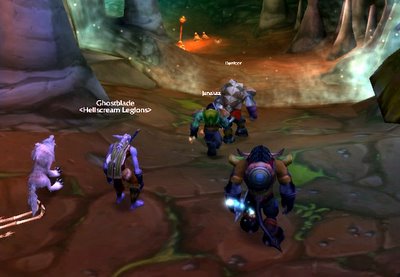
You enter Wailing Caverns through a cave in the Lushwater Oasis. Much like the Deadmines on the Alliance side of the ocean, you’ll have to wander through "public" caves populated with elite monsters (mostly raptors) in search of the entrance to the Instance Dungeon itself.
Monsters in the Wailing Caverns tend to average around level 19, but naturally almost all of them are elite monsters, making them much tougher than ordinary monsters of their level. I ventured into the mines with a party of four players:
- Haokan (me), a level 23 Shaman specialized in healing
- Danicor (the party leader), a level 24 Shaman specialized in close combat
- Junasaz, a level 20 Rogue
- Ghostblade, a level 20 Hunter
As usual, not every member of the party was equally competent. In my role as primary healer, I had little trouble keeping up with the healing duties most of the time; Danicor did a good job of holding the attention of the monsters, and Junasaz did a good job of crowd control by sapping (stunning) some members. Ghostblade, on the other hand, had a tendency to start fights before the rest of the party was ready and to draw extra monsters into ongoing fights. He also tended to be a "ninja looter", trying to get treasure that he didn’t really need, so Danicor took direct control of loot distribution. Even then, Ghostblade couldn’t seem to follow directions when told to "/roll" for a special item: generating a random number in a "roll off" with the highest number receiving the item.
Despite two wipeouts, though, the party functioned as a pretty effective monster terminating machine most of the time. I can’t really give good guidance about where to go in the Caverns, since I was just following Danicor most of the time and not keeping track of the path.
I can tell you that you will spend a lot of time fighting the Druids of the Fang. These are night elf druids who will invariably have escorts of some kind around them, be they raptors, serpents, or elementals. You can generally expect to have to fight one druid and two escorts in a given encounter. When dealing with these groups, we generally sent Junasaz to sap the druid, pounded down the escorts, and then turned on the now-lonely druid. Druids of the Fang typically cast the Wrath spell a few times and then change into a fighting form. Their fighting form is serpentine rather than the bear or cat form of player druids, but they don’t seem to have any special advantages because of it.
There are a lot of quests available for Wailing Caverns, so it’s a good idea to make sure you’ve shared quests with your traveling companions before entering the instance. I’ve still got incomplete quests in there, so hopefully I’ll go back soon and get more screencaps.
$120,000 Placebo
Sons Pay $119,400 for Ginseng to Help Mom$120,000 for some old plant roots; I think the lady could have had knee replacement surgery repeatedly for that much money. A search of PubMed for “ginseng healing” only turned up 14 articles, none of which indicated any significant benefits for any kind of knee or joint ailment. Some of the studies indicate that it may have some benefit for the regeneration of damaged blood vessels, and there are some studies showing potential “quality of life” benefits when ginseng is used as a dietary supplement, but there’s absolutely nothing to suggest that ginseng will provide any significant benefit to this lady’s condition.
SEOUL, South Korea - A family hoping to cure their mother's weak knees bid nearly $120,000 at an auction for a set of wild ginseng roots that included specimens 110 years old.
The package of six roots sold for 125 million won ($119,400), Yonhap news agency reported Sunday, citing the Korea Wild Ginseng Appraisal Association. An entrepreneur and his brothers placed the winning bid to help cure their mother's ailing knees.
Ginseng is highly valued in Korea for its potent healing benefits.
So we have $120,000 that could have been used for modern medical treatment with documentable benefits wasted on “alternative therapy” instead. The mind boggles.
Wednesday, November 23, 2005
Another Shameless Endorsement of the Absurd
Based on the adventures of real-life psychic and crime solver Allison Dubois (portrayed by Emmy-winner Patricia Arquette), the show has neatly positioned itself as both an intriguing paranormal mystery show and an above-average family drama. The relationship between Dubois and her husband Joe (Jake Weber) occupies center stage, as he tries to cope with having a wife that not only sees the future and communicates with dead people, but also frequently gets called on by the district attorney’s office at all hours of the day or night.Real-life psychic and crime solver? Can we please cut back on the mindless credulity a little bit? Yes, Allison Dubois is a real person, but she has yet to do anything to conclusively demonstrate that she has psychic abilities.
Supposedly she sent her psychic impressions about crimes to an assortment of law enforcement agencies around the country, and the Texas Rangers contacted her shortly thereafter to assist them with a missing persons case, but the Texas Rangers deny her claim.
She also claims to have helped the Glendale, AZ police department, but they also deny ever having worked with her.
Indeed, as far as I can tell, no law enforcement agency has ever called her for assistance, and she has never contributed any useful information to a case, so can we please stop shamelessly promoting her? If you’re going to essentially advertise for her, you should at least send her a bill.
ID’s True Colors Showing Again
Why poke a stick in somebody’s eye if you don’t have to? If you’re going to have an intelligent design course and call it mythology, I think in the very least it’s a slap in the face to every Judeo-Christian religion that’s out there.Did somebody at the Discovery Institute forget to go over the Incompetent Design talking points with Senator O’Connor? ID is supposed to a completely scientific theory, isn’t it? I thought that it’s proponents claimed that there was nothing religious about it at all.
Why, then, is comparing ID to mythology a slap in the face to Jews and Christians?
As usual, the ID movement claim to be non-religious one moment and then show their true colors the next: ID is just religion masquerading as science.
Tuesday, November 22, 2005
Crystal Ball
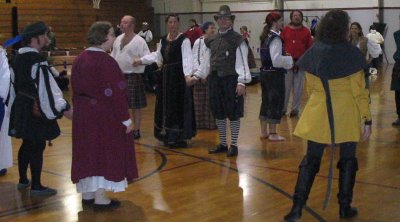
I must say that I was rather remiss, in that I never did catch the name of the lord who was teaching the English Country Dance class that I joined. Bad Runolfr! He taught Chestnut, Hyde Park, and Jenny Pluck Pears. Chestnut and Hyde Park are fairly easy dances for three and four couples, respectively, that I had not danced previously, and they were the reasons that I took the class. I thought Jenny Pluck Pears was a no-brainer, but it turns out that the vagaries of Inter-Kingdom variations caught me there. In Meridies we do a little trick with the chorus that isn’t done in the Middle Kingdom, so I caused a minor train-wreck on the first chorus. Honestly, I think the Meridien variation is more fun, but a quick peek into a nearby copy of Playford’s The English Dancing Master showed it to be less authentic. That said, I’ll have to add that to my list of dances to discuss before the music starts when I’m dancing in a mixed-kingdom set.
After lunch I took Lady Tsire’s class on pavans and galliards. I’m no stranger to pavans, and they’re generally so slow that you can figure out what to do from cues or hints from your partner as long as you know the basic pavan steps. Documentation-wise, pavans are more of a style than a specific series of steps; detailed choreographies are mostly SCA inventions. Lady Tsire taught Entre Courante, Carolingian Pavan, and the Earl of Salisbury Pavan, which are all SCA choreographies that vary in their stylistic authenticity. Entre Courante was the only one that was new to me, but I was in Lady Tsire’s class for the galliard segment, anyway (that and to chat with Tsire, who is just a bundle of fun). Galliards, like pavans, are a style rather than a specific choreography, and there aren’t any specific SCA arrangements that I know of, possibly because galliards are so... aerobic. Nonetheless, I wanted to refresh myself on galliards, and I found that a galliard set was planned for the ball following the Carolingian Pavan (historically, a galliard often follows immediately after a pavan).
My final class of the day was Master Sion’s 15th-century Italian class. He taught Leoncello Vecchio, Villanella, and Anello. Leoncello Vecchio and Villanella were both new to me, and they’re also good because they’re not "big set" dances, just any number of couples dancing as they want (which usually means dancing in a "race track" circle). I have to check my music collection to see if I have appropriate recordings. If I do, my students have something to look forward to (or fear, as the case may be).
We were bad kids and skipped the last class period to go back to our hotel, rest, swim a bit in the pool, and change into our evening garb. We attended feast at this event, which had good and bad points. On the good side, they had live entertainment which was actually quite entertaining. On the down side, the feast itself was un-thrilling. According to several regulars, that’s the usual situation, so we’ll be skipping feast on any future visits.
Following feast was a Baronial court that lead directly into the ball. On the upside for the ball, there are a lot of dancers of both genders in the hall, and the great majority know what they’re doing. On the downside, a basketball court is not the most romantic venue for a renaissance dance, and there was no real effort to try to dress it up.
Crystal Ball is arranged in six sets of about ten dances each. That’s a huge dance list. I’m a major dance geek, but it was after midnight before the third set was over, and I had to drive eight hours the next day, so I didn’t make it to the fourth set. Even half of Crystal Ball is more dancing than you’re like to see in Meridies at anything but Saltare.
EDIT: The missing camera reappeared. Fjorleif was opening the car trunk, and it practically fell at her feet. Apparently it somehow got caught in a cavity of the trunk lid during our drive to the hotel. Anyway, we have no pictures of the ball itself, but we had one picture of the Scottish Country Dance class (seen at the top, now) and a couple of short videos that I'll have to host somewhere eventually.
This pretty much concludes my 2005 (Anno Societatus XL) event year. My next planned event is Mid-Winter Arts & Sciences in the Barony of South Downs in February.
Wednesday, November 16, 2005
Life as Wine Yeast
Tuesday, November 15, 2005
Tom Toles on Kansas

It's apparently well-loved by scientific bloggers everywhere. I hope I'm not getting into a serious copyright infringement situation (although I think Tom has already made all the money he's likely to make on this particular cartoon).
Monday, November 14, 2005
Unusual Link of the Day
Fighter's Collegium Aftermath
My class went alright, I guess. We didn't get as far as I wanted to go, since everybody scattered to find their armor when they found out that this was meant to be a practical, weapons-on sort of class. That delayed the start by almost half an hour, so we never got past the single-rapier portion of the class. C'est la vie.
The post-feast revel was predictably minimal; there were never more than six dancers, and I think we only got through five or six dances at most. Knights are supposed to be well-grounded in dance, but that's a "requirement" that obviously isn't enforced with any rigor. C'est la vie, aussi. (Ysabel is probably going to chastise me for my bad use of French when she reads this... I plead lack of practice.)
In better news, I am now apprenticed, although the formalities probably won't take place until Midwinter Arts and Sciences in the Barony of South Downs. I'll not announce the name of my gracious Laurel until things are official, but anyone who knows me personally should be able to guess in an eyeblink.
Next weekend I'll be at Crystal Ball, and I hope to see a few of my readers there. After that, I should have a couple of months off from eventing.
Wednesday, November 09, 2005
As If It Would Prove Anything
I presume that Mr. Dougherty is taking this "bold" step in response to allegations that he attempted a similar claim against the town visitor's center in Nederland, CO, in 1976. At least one record -- belonging to the Colorado Bureau of Investigation -- shows that Dougherty plead guilty to filing a false police report in that incident.
Whether Dougherty could pass a polygraph test is immaterial, though. Polygraph test results are not admissable in court, and with good reason. The techniques for passing a polygraph test -- whether you're lying or not -- are freely available on the internet. Offering to take a polygraph test just gives the illusion of offended sincerity; it does nothing to demonstrate the truth of a claim.
A Resounding Defeat for IDiocy
Apparently the citizens of Dover quickly got tired of their school board making them a laughing stock in the public media, because they replaced all eight of the incumbents with Democratic candidates who are against introducing ID into science classes.
You can read about it in Yahoo News.
On the other hand, things are going to the dogs in Kansas, but we really knew that was coming. The Kansas board is currently packed 6-4 with IDiots, but several of those IDiots will be up for re-election next November. Hopefully their IDiotic science standards won't do too much damage over the next twelve months, and the good citizens of Kansas will toss the IDiots off their school board, as well.
Swetnam Fencing 5: Sword and Dagger Inside Parry
Instead, you should bring your dagger hilt down and to the inside while keeping the point high. This will push the attack away to your right.
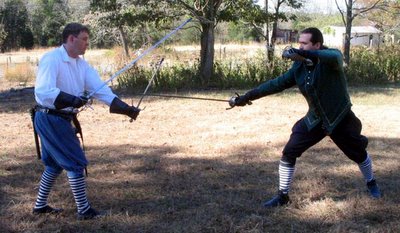
At the same time, raise your sword hilt until it's over your head, with your knuckles turned upward, and thrust down at your opponent's head, body, or sword arm.

Swetnam calls this thrust a mountanto, and it's just about his favorite attack. You'll need to practice it quite a bit, though, as it's not really a natural motion, and you can easily tangle yourself up if you haven't got the hang of it. When you get it right, though, it does work very well.
Back to Part 1
Tuesday, November 08, 2005
Stop that! It's Silly!

Monday, November 07, 2005
Swetnam Fencing 4: Rapier & Dagger Guard and High Parry
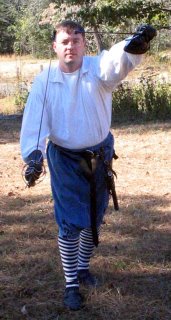 The rapier and dagger are Joseph Swetnam's favorite weapon combination; his next favorite weapon is the staff, which he promised to write about in a second book which was either never published or lost to history.
The rapier and dagger are Joseph Swetnam's favorite weapon combination; his next favorite weapon is the staff, which he promised to write about in a second book which was either never published or lost to history.As with most fencing "masters" of the time, Swetnam regarded the dagger primarily as a defensive tool. It's lacks the reach to use for a serious offense -- particularly at the "true distance" that Swetnam recommends -- but it can hold a sword point at bay reasonably well while you attack with your own sword.
As with the single rapier, Swetnam suggests a pretty closed stance with most of your weight on your right (lead) foot. You then lean forward as far as you reasonably can without being unbalanced. Awkward at first, yes, but this puts your legs so far back that an attack directed at them is pretty futile.
Hold your sword low and slightly to your side with the point up in front of you. Hold your dagger straight out high and horizontal with the tip very close to your sword point. This position concentrates your defenses around your head -- a very sensible thing to do when you've stuck your head out as far as the basic stance puts it. You've made your head a very attractive target, but as we saw before, Swetnam likes to be able to predict where the enemy will strike.
The close points protect you from a "wrist blow", a quick downward cut to your face thrown from the wrist. Whether you have much to worry about from such attacks in the SCA depends on your local Kingdom rules and whether they allow tip cuts. You might see people trying to quickly drop the point and thrust to your face, too, so it's best to prepare for such an attack.
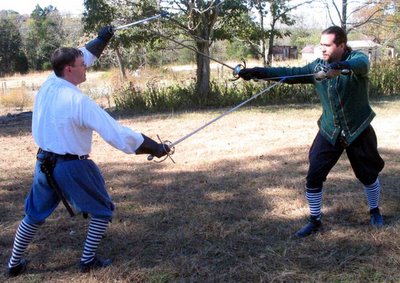
The basic defense against a thrust to your face is to slip your dagger under the attacking sword and lift it up. Naturally you should take this opportunity to simultaneously deliver a counter-thrust of your own.
I'll be discussing more of the basic sword and dagger defenses and ripostes as the week continues.
Part 5
Friday, November 04, 2005
Bad Batman Science
It does not have good science. Oh, there are good bits here and there. The Batmobile, for instance, is a real vehicle built specifically for the movie, and it really can jump a short distance without a ramp (I’m sure you can look up details online if you’re interested).
It’s the villain’s master plan that’s the real culprit. If you haven’t seen the movie yet (where have you been hiding?) and you don’t want to know the details, you should stop reading this article right now.
The dastardly villain, Ra’s Al-Ghul, has teamed with the corrupt Dr. Crane (aka the Scarecrow) to poison Gotham City’s water supply with a drug that causes irrational fear. The plan is to destroy Gotham by driving the citizens mad with fear and letting them tear the city apart.
There’s a major plot point in the way, though: the fear drug only works when inhaled. That’s why the population hasn’t already gone mad from drinking the tainted water. To complete their evil plan, the villains have stolen a high-powered microwave generator to rapidly boil the city water supply into cloud of toxic steam.
Herein lie two problems. First, why hasn’t Gotham City been overrun by cases of people who have gone crazy after taking a hot shower, boiling a pot of spaghetti, making a pot of tea, etc. There are numerous mundane situations that would expose a person to tainted water vapor, so keeping this evil plan a secret wouldn’t be feasible.
The second and more obvious problem is the microwave machine that they plan to use to vaporize the water. They stand right next to it when they turn it on, causing water in nearby pipes to boil into steam, bringing madness to a portion of the city. Note that human bodies are roughly 80% water: anyone standing next to this machine when it was activated would promptly explode! Nonetheless, intact human bodies remain in close proximity to the microwave machine as the villains try to transport it – running all the time – to the central hub of Gotham City’s water distribution system.
So there are two huge realism issues that you’re going to have to ignore when watching Batman Begins. That’s not so bad really, as long as you know that you’re deliberately suspending disbelief on these issues and not accepting this chain of events as scientifically plausible.
Thursday, November 03, 2005
Swetnam Fencing 3: Single Rapier Compass-Step Void
Another of his methods of trying to control his opponent's behavior is to reverse his stance. Many people use this stance because they intend to use a hand parry to get control of the opposing blade before or during their attack. Swetnam's primary objective, however, is to offer the left shoulder as bait.
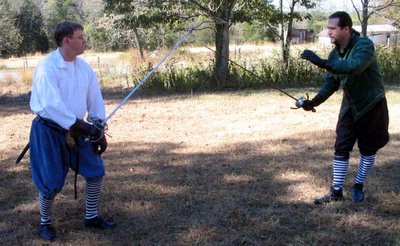 When your opponent thrusts at your apparently open left shoulder, you step back with your left foot to pull your shoulder back out of range. At the same time you thrust into your opponent's sword arm, which he has conveniently put out into range for you. As usual, I tend to add a hand parry for good measure and to keep my opponent's blade under control as much as possible.
When your opponent thrusts at your apparently open left shoulder, you step back with your left foot to pull your shoulder back out of range. At the same time you thrust into your opponent's sword arm, which he has conveniently put out into range for you. As usual, I tend to add a hand parry for good measure and to keep my opponent's blade under control as much as possible. On the remote chance you haven't figured this out already, all of my instructions assume that you're a right-handed fighter; you should reverse all of the left-right directions I've been giving if you're holding the sword in your left hand. In this, I'm just following Swetnam's convention, as well as giving instructions the way the majority of fencers will use them.
On the remote chance you haven't figured this out already, all of my instructions assume that you're a right-handed fighter; you should reverse all of the left-right directions I've been giving if you're holding the sword in your left hand. In this, I'm just following Swetnam's convention, as well as giving instructions the way the majority of fencers will use them.Part 4
Wednesday, November 02, 2005
Swetnam Fencing 2: Single Rapier Outside Parry
The counter for an outside thrust is to keep your hilt out to the right and place your left hand on the blade of your sword. Using your left hand, you gain extra leverage to position your blade to parry the attack.
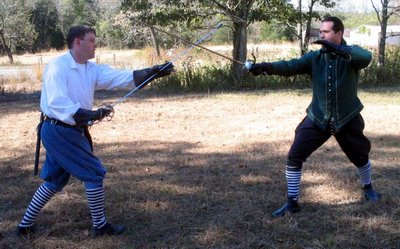 With your hand on your blade and your opponent's blade under your control, you can step forward to deliver your counterthrust. Again, you get a convenient opportunity to grip your opponent's blade so that you can keep it under control while you launch your attack.
With your hand on your blade and your opponent's blade under your control, you can step forward to deliver your counterthrust. Again, you get a convenient opportunity to grip your opponent's blade so that you can keep it under control while you launch your attack. In practice, we've discovered that you can use this parry offensively. With your left hand helping to control your blade, you can deliver a very strong beat against your opponent's blade to throw it off target without letting your own point wander off target.
In practice, we've discovered that you can use this parry offensively. With your left hand helping to control your blade, you can deliver a very strong beat against your opponent's blade to throw it off target without letting your own point wander off target.Part 3
Monday, October 31, 2005
Swetnam Fencing 1: Single Rapier Guard and Inside Parry
 I've mentioned Joseph Swetnam a few times before. He was a prize-fighting fencer in England in the late 16th century, and he published a fighting manual in 1617 called Schoole of the Noble and Worthy Science of Defence. I'll be teaching a class on this style at the upcoming Kingdom Fighters' Collegium, so I prevailed upon Hawk to assist me with a few pictures the day after our Halloween party.
I've mentioned Joseph Swetnam a few times before. He was a prize-fighting fencer in England in the late 16th century, and he published a fighting manual in 1617 called Schoole of the Noble and Worthy Science of Defence. I'll be teaching a class on this style at the upcoming Kingdom Fighters' Collegium, so I prevailed upon Hawk to assist me with a few pictures the day after our Halloween party.Joseph Swetnam was a cautious man, at least in some ways. He advocates fighting an opponent from as far away as possible. In fact, he considers "true distance" to be about twelve feet.
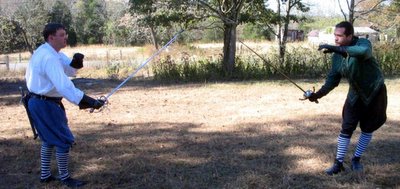
As you might imagine, it's rather hard to go on the offensive from "true distance", so much of Swetnam's technique is defensive, striving to gain control of an opponent's blade during their approach and then delivering a riposte. For example, if your opponent attempts an "inside" thrust to your body, you can easily move your hilt from right to left to parry the attack. This move also tends to create an opportunity for you to grip your opponent's blade with your free hand. Swetnam doesn't actually mention this hand parry, but I consider it a good measure.

From this position, you can step toward your opponent and counter-thrust while keeping his blade under control.

I'll be adding more pictures and discussion over the next few weeks as I prepare for the Collegium, but I don't want to throw too much into a single post. Besides, it grows late here, and I have to work for a living.
Part 2
Being Excellent to Each Other
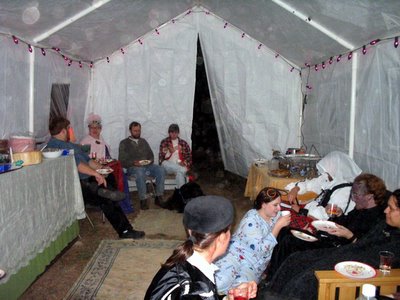
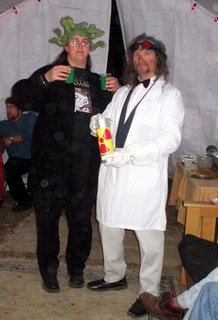 Naturally we had attendees in costume; we even had a costume contest with a prize. Unfortunately I was a bit distracted and failed to keep the camera about to get pictures of all the different costumes in attendance, but I did manage to grab this one of Ursula and Hawk as Medusa and the Mad Scientist.
Naturally we had attendees in costume; we even had a costume contest with a prize. Unfortunately I was a bit distracted and failed to keep the camera about to get pictures of all the different costumes in attendance, but I did manage to grab this one of Ursula and Hawk as Medusa and the Mad Scientist.We also had a vampire, a demon, a furry, two Blue Sun Corporation agents, Boccaccio the Bad and his fuzzy-faced fraulein, Maleficent, a Pict-zie, a Harry Potter character that I'm not familiar with (not being much of an HP reader), the Phantom of the Opera, and a smattering of SCA garb.
Special congratulations go out to Jenn, though, who had the prize winning costume of the evening. Not only did she produce a convincing ensemble, she also got extra points for irony with her Cruella DeVille costume (Jenn being a vegetarian).
Other activities included the traditional Bobbing for Apples in the hot tub, an event that was a virtual shutout. Adam cast off most of his Phantom costume and was practically in the tub, waist deep, inverted, snatching apples. I think he ended up with like 75% of all the apples that originally went in the tub.
We also had a scary-but-tasty food contest which included a jello fish bowl, a "vomit" dip, "finger" sandwiches, and an assortment of other creepy delicacies. Sorry, all, but my memory is a bit fuzzy from the "vile green stuff" in the punch bowl. By the way, blood orange juice (if you can find it) and rum make a great mix; have to think of a suitably Halloween-ish name for that concoction. Something bloody, since it's certainly the right color.
There was a bonfire and dancing and much merriment, and I do think a good time was had by all. Most of the guests stayed overnight (many of them being in no condition to drive anyway), and I thank them profusely for their assistance in clearing up the party aftermath. Once we could pry them out of their puppy pile, that is...

Friday, October 28, 2005
Deanimator
A New Dance Resource
Sorry. I just found a link to an online translation of Fabritio Caroso's 1581 dance manual, Il Ballarino. I haven't looked through much of it yet; just finding it got me excited enough to post. I look forward to delving through it in search of "new" 16th century Italian dances to research, develop, and perform.
The Queen's Dance Geek is a happy!
Thursday, October 27, 2005
College of Skepticism
WoW: Halloween Tricks

 I love Halloween in the World of Warcraft. I've received wands that "costume" people, candy that restores health, apples that restore health and increase stamina, and masks of troll, night elf, and dwarf faces.
I love Halloween in the World of Warcraft. I've received wands that "costume" people, candy that restores health, apples that restore health and increase stamina, and masks of troll, night elf, and dwarf faces.I've also received some good tricks. I've been turned into a black cat, a skeleton, a mini-Diablo, and an undead pirate.
Halloween rocks!
Tuesday, October 25, 2005
WoW: Return to the Deadmines
Once on the list, I needed to get to Moonbrook, which lies south of Sentinel Hill. You can work a series of quests to find out where the entrance to the Deadmines lies, or you can just ask someone, or you can look for the very visible spire shown in the image below.

Once in Moonbrook, you need to go to the southwest corner of the village to look for a large building (shown below).
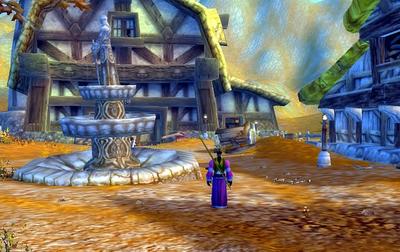
There's a meeting stone just southwest of the building that's a bit of a giveaway, too.
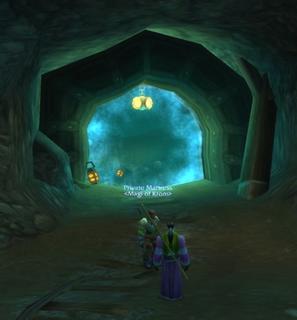 Once you get into the mines themselves, you'll need to work your way west, taking turns as needed until you find the Instance, seen in the image to the right. Once you go through the shiny circle, monsters stay dead when you kill them, and you'll stop seeing adventurers who aren't members of your party.
Once you get into the mines themselves, you'll need to work your way west, taking turns as needed until you find the Instance, seen in the image to the right. Once you go through the shiny circle, monsters stay dead when you kill them, and you'll stop seeing adventurers who aren't members of your party.On your way to the entrance, you'll pass a "fork" in the tunnels where you can turn right or go across a bridge into an area that looks blue or purple on your mini-map. I unfortunately forgot to grab a screencap of this point; I'll update this article if I remember it on a future pass through the dungeon. This off-color area is where you'll find the Miners' Cards you need to complete the Collecting Memories quest. You'll also find undead monsters in fairly dense clusters that can be hard to fight. Best have a full group just to work this area, since crowd-control spells like Polymorph don't work on undead.
 The Deadmines are a fairly straightforward dungeon. Side paths generally lead to dead ends pretty quickly, so you won't have much trouble finding your way to the key encounters. The first Boss you'll encounter will be Rhahk'Zor the Foreman, a large ogre. I saw stunning effects from the warriors work on him, but I remember he was immune to something I tried as a hunter; maybe it's poison that doesn't work. Anyway, with two fighters and a druid in bear form holding his attention, a priest keeping them health, and a steady stream of Arcane Missiles from me, he went down without much difficulty. There are a couple of Overseers in the same room where he waits, but if you pull him when he's close to the entrance, you shouldn't have to fight them at the same time.
The Deadmines are a fairly straightforward dungeon. Side paths generally lead to dead ends pretty quickly, so you won't have much trouble finding your way to the key encounters. The first Boss you'll encounter will be Rhahk'Zor the Foreman, a large ogre. I saw stunning effects from the warriors work on him, but I remember he was immune to something I tried as a hunter; maybe it's poison that doesn't work. Anyway, with two fighters and a druid in bear form holding his attention, a priest keeping them health, and a steady stream of Arcane Missiles from me, he went down without much difficulty. There are a couple of Overseers in the same room where he waits, but if you pull him when he's close to the entrance, you shouldn't have to fight them at the same time.Important safety tip: Defeating Rhahk'Zor apparently releases a patrol, consisting of an Overseer and a spellcaster (I forget what they're called). I'm not entirely sure whether they're triggered or simply pop up on a regular schedule, but their arrival time is pretty suspicious. It's a good idea to go back and kill them, since they'll generally arrive just in time to hit you in the back about the time you're fighting the next boss if you don't.
Past Rhahk'Zor, you'll soon find yourself in the Lumber Room, where Lumbermaster Sneed lurks in his giant Shredder machine. Sneed and the Shredder are the objects of a quest that you can get in the Dwarven District of Stormwind. Make sure your group shares all of their quests before you get to this point in the dungeon.
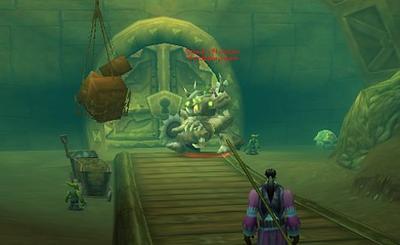
This guy can be pretty harsh. The Shredder is heavily armored and does a lot of damage. There are also a lot of other goblins in the room, and you don't want to be fighting them at the same time you're fighting the Shredder, so you should pull them out and kill them first. Beware when you bring the Shredder down; Sneed will fall out and start attacking you in just a moment, and he's not a weakling, either.
Again, lookout for the patrol before you move on.
Past the Lumber Room, you'll follow a tunnel to the Smelter. This room has a long spiral ramp leading down to a lower floor, and you'll find Gilnid the Smelter himself at the bottom.
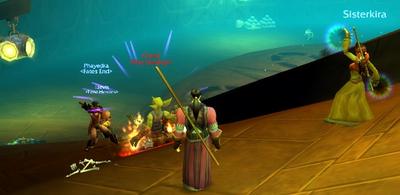
The monsters here are goblins engineers who either throw firebombs or shoot guns. The gunners will also drop little golems that will run up to attack you. If you pull more than one or two of these guys, you can find yourselves overwhelmed surprisingly fast. There are also rooms hidden under the ramp where more goblins lurk, and they'll come out if you move on to the central platform at the bottom; that's how we pulled too many goblins and got wiped! Stick to the outside wall when you come down the ramp and minimize the number of goblins you have to fight at once.
Again, lookout for the patrol.
Past the smelter, you'll follow the tunnel down to a large door with a cannon pointed at it. Somewhere along the way you have to pick up the charge to prep the cannon for firing. I've never been the one who picked that item up, so I don't know where you get it, but I suspect that it's near impossible to get that far without someone in your party picking it up. Whoever has it needs to fire the cannon.
Beyond the blasted door, is the secret dock of the Defias Pirate Battleship. You can fight your way down the dock, or you can do what we did on this trip: follow the coast around toward the other end of the dock, then swim across to it.
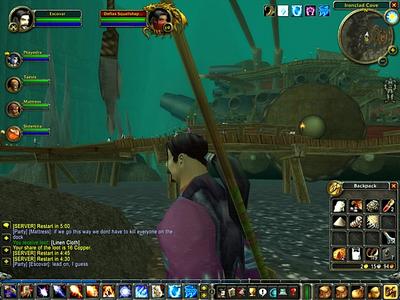
You'll have to fight a few goblins, but you may find that preferable to fighting your way through all the pirates. I think we only tried the end run because we were running out of time (see below).
At the end of the dock, you'll reach the boarding plank to the pirate ship, which is guarded by Mr. Smite.

As you can see, Mr. Smite is a large Tauren warrior. A couple of Defias assassins (I don't remember exactly what they're called) will join him when he starts fighting you. He'll start with a single one-handed weapon, but after taking a certain amount of damage, he'll use an enhanced version of the Tauren "War Stomp" to stun your entire party. This is annoying, because it lasts a fairly long time, and his companions will keep hitting you while he runs off to get a different weapon. He comes back with two weapons after his first stomp.
I recommend detailing one fighter to keep Mr. Smite busy while your party concentrates on taking out his buddies first. We didn't do that, and we got wiped. From previous experience, however, I know that he has at least one more Stomp in him before he goes down; he'll come back with a two-handed weapon for the Final Round.
Alas, my report on this venture to the Deadmines ends here, because Blizzard rebooted the server shortly after Mr. Smite and his cronies wiped us out (that's why we were in a hurry).
Disaster in the Making
“Under my definition, a scientific theory is a proposed explanation whichThe natural implication of Behe’s definition is that a “theory” doesn’t need to demonstrate any level of accuracy to be scientific, so we should discuss any and all unproven theories in grade school science classes.
focuses or points to physical, observable data and logical inferences. There are
many things throughout the history of science which we now think to be incorrect
which nonetheless would fit that – which would fit that definition. Yes,
astrology is in fact one, and so is the ether theory of the propagation of
light, and many other -- many other theories as well.”
“And let me explain under my definition of the word ‘theory,’ it is -- a senseWhat Behe neglects to mention is that we don’t teach incorrect theories to grade school students! We don’t teach alchemy alongside chemistry; we don’t teach astrology alongside astronomy, and we don’t teach the “Flat Earth Theory” alongside modern geography! The AAAS definition of a scientific theory requires “a well-substantiated explanation of some aspect of the natural world, based on a body of facts that have been repeatedly confirmed through observation and experiment”, but Behe’s definition does not.
of the word ‘theory’ does not include the theory being true, it means a
proposition based on physical evidence to explain some facts by logical
inferences. There have been many theories throughout the history of science
which looked good at the time which further progress has shown to be incorrect.
Nonetheless, we can’t go back and say that because they were incorrect they were
not theories. So many many things that we now realized to be incorrect,
incorrect theories, are nonetheless theories.”
Consider the consequences. On the odd chance that the Dover School Board were to actually win their case, Behe’s definition of a scientific theory would be enshrined in legal precedent. That would bring a horde of astrologers, phrenologists, and homeopathic “doctors” into the court system to sue for equal time in classrooms, claiming that their “theories” are every bit as scientific as ID, so they also deserve equal time in science classrooms. Science education in America could be deluged with unproven and unprovable nonsense. Kids could graduate from high school without a clue how the world actually works, making them even more vulnerable than they already are to baseless quackery of every sort. America would be jumping right out of her leading place in scientific advancement and achievement.
China would love it.
Sunday, October 23, 2005
SCA: Wine List Equestrian Activities
 This weekend was Wine List, an SCA event put on by the Shire of Glynn Rhe. This event had no fencing and no dancing, so you might be wondering what would get me to it. The answer is that the event had equestrian activities, and the marshals from our shire were running them. One of those marshals just happens to be my good Lady Fjoleif. I was actually planning to do some riding at this event, but I ended up spending all my time taking pictures. Lady Lora and Lady Fjorleif were the only authorized equestrians to bring horses to the event, but we managed to authorize six people at the beginner level for future events.
This weekend was Wine List, an SCA event put on by the Shire of Glynn Rhe. This event had no fencing and no dancing, so you might be wondering what would get me to it. The answer is that the event had equestrian activities, and the marshals from our shire were running them. One of those marshals just happens to be my good Lady Fjoleif. I was actually planning to do some riding at this event, but I ended up spending all my time taking pictures. Lady Lora and Lady Fjorleif were the only authorized equestrians to bring horses to the event, but we managed to authorize six people at the beginner level for future events.Safety class is the first step in the authorization process. Most people who have their own horses know the basics, but there are additional hazards when you start handing long poles with sharp points on the ends to people on horseback. Whether you're a rider or just ground crew, you need to know the rules for handling lances, javelins, and wooden swords in the riding area.
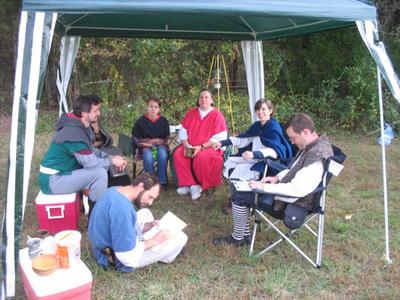
The basic requirement to receive a beginner authorization for equestrian competition is shockingly simple, to my mind. You need only be able to ride the "heads" course at a walk. This means weaving your horse through a series of poles with targets perched on top. Lora's targets are wig stands with features painted on them and silly hats. Below, you can see Reinmar on his authorization run.
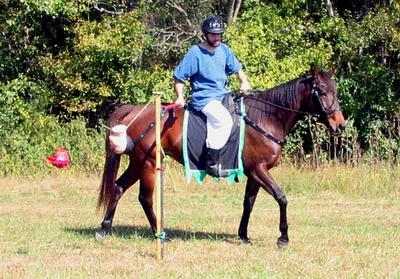 After we finished authorizations, we moved on to the more entertaining portion of the day's events. Jousting at a quintain is one of the standard SCA equestrian competitions. A quintain is a pole with a rotating crossbar mounted on top. The crossbar has a target on one end and a counterweight on the other. The counterweight is generally a sandbag. If you've seen the move A Knight's Tale, you saw the hero practicing with a quintain. The idea in the SCA game is to strike the target with a lance and make the crossbar spin as many times as you can.
After we finished authorizations, we moved on to the more entertaining portion of the day's events. Jousting at a quintain is one of the standard SCA equestrian competitions. A quintain is a pole with a rotating crossbar mounted on top. The crossbar has a target on one end and a counterweight on the other. The counterweight is generally a sandbag. If you've seen the move A Knight's Tale, you saw the hero practicing with a quintain. The idea in the SCA game is to strike the target with a lance and make the crossbar spin as many times as you can.We didn't bother with a crossbar at Wine List, though.
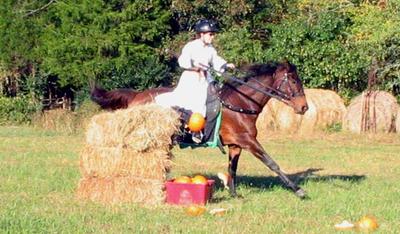 That's right, we used pumpkins as targets. While the pumpkins we had were surprisingly resilient to lance blows, we still ended up with a substantial heap of smashed pumpkins at the end of the day. We also set some pumpkins on the tops of the poles in the heads course to see how that would go. I think Lora and Fjorleif are hoping to make smashing pumpkins an annual equestrian challenge in the future.
That's right, we used pumpkins as targets. While the pumpkins we had were surprisingly resilient to lance blows, we still ended up with a substantial heap of smashed pumpkins at the end of the day. We also set some pumpkins on the tops of the poles in the heads course to see how that would go. I think Lora and Fjorleif are hoping to make smashing pumpkins an annual equestrian challenge in the future.
Thursday, October 20, 2005
WoW: Druidic Milestone

Fortunately, the quest giver provided a spell with which to quickly reach Moonglade. After communing with the bear, getting back to Darnassus was a simple matter of activating my Hearthstone.
Of course, communing with the Bear Spirit wasn't the end of the quest. She had to demonstrate that she had "learned the strength of the bear" by defeating Lunaclaw, a creature that was sort of a cross between an owl and a bear (D&D players will get the idea immediately). That required a trip over the seas to Auberdine.
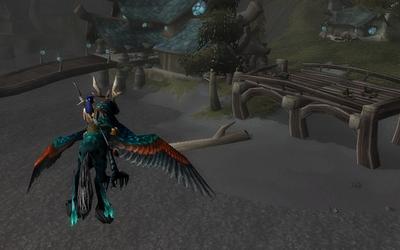
After defeating Lunaclaw, Gullveig returned to Darnassus to complete the quest, where she acquired the ability to transform into a bear. I have yet to test this new form in battle...
Evolution Scientists Beat ID Scientists 20-to-1
The terms of the IDEA list are pretty vague, especially since "Darwinism" is actually an early variant of the Theory of Evolution, which has changed since Charles Darwin first proposed it in the 19th century. The "Darwinism" variant of the hypothesis states that all evolution takes place gradually and is driven purely by natural selection. The theory of Punctuated Equilibrium corrects the Theory of Evolution with regard to pure gradualism, and the modern Theory of Evolution accepts other factors (like sexual selection) that affect the success and development of species.
"mike" also tried to claim that the signatories on the IDEA list are not religious. There’s actually nothing on that list to indicate their religious affiliation (or lack thereof), so his claim is baseless, but many of them are known to be Christians who believe the “intelligent designer” to be God. Michael Behe, for example is Catholic, and recently admitted in the Dover, PA, court case over ID that he believes God is the "designer". We can therefore conclude that "mike" was being deliberately deceptive.
The IDEA list has no more than 479 names at the time of this posting (it’s numbered up to 481, but I saw at least two blank lines – 48 and 49 – in it).
The Discovery Institute also has a list of scientists who "are skeptical of claims for the ability of random mutation and natural selection to account for the complexity of life". Their list of scientists who agree to this vague statement has a little over 400 names on it, and I haven’t read through it to see how much it overlaps the IDEA list.
More recently, Shovel Bums LLC, a resource for archaeology and CRM professionals, ran their own petition to collect signatures from scientists who "do not consider Intelligent Design to be a fact-based science appropriate for teaching in public schools because it is theistic in nature, not empirical, and therefore does not pass the rigors of scientific hypothesis testing and theory development."
In four days, Shovel Bums collected 7,733 signatures. Additional signatures after the four-day recruiting drive brought the total up to 11,622 before it was closed. That’s 24 times the number of signatures that the pro-ID crowd has been able to accumulate in four years. Unlike the IDEA and DI lists, the Shovel Bums petition is very specific about the statement to which the signatories agree. Furthermore, many signatories to the Shovel Bums list also indicated their religious affiliation on the petition, and they are clearly a diverse group (unlike ID-ers).
ID-ers should be wary of entering a name-dropping contest with the real scientific community; it’s a battle they’re doomed to lose.
Wednesday, October 19, 2005
WoW: It's Halloween!

As if mere decoration weren't enough fun, you can also go trick-or-treating at the inns. You can only try trick-or-treating the innkeeper once per hour, and sometimes you're the one who get's tricked. For instance, I once received candy, once received a wand that turns friends into ghosts, and once got turned into a toad (I got better!).
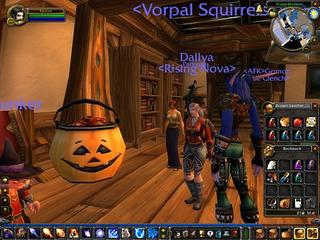
And at least one of the traditional Halloween party games has been implemented in the World of Warcraft: Bobbing for Apples!
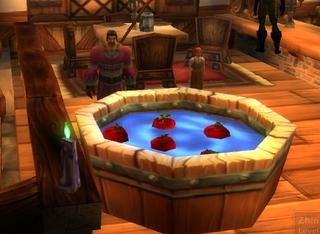
The developers at Blizzard are obviously having entirely too much fun with this stuff.
Tuesday, October 18, 2005
Upcoming Dance Activities
Also, coming up in November, I will be making the journey up to St. Louis for my first trip to Crystal Ball, a Midrealm or Calontir event (I'm not exactly sure which claims the Barony of Shattered Crystal) which I understand has a huge dance turnout (as witnessed by Lady Francesca dei Rossi, who made the journey last year).
Monday, October 17, 2005
Dr. Ego Takes the Stand
 According to a Yahoo News article, Dr. Michael Behe is testifying for the defense in the Dover, PA school curriculum case today.
According to a Yahoo News article, Dr. Michael Behe is testifying for the defense in the Dover, PA school curriculum case today.Behe is the author of Darwin's Black Box, a book in which he tries to sell readers on the idea that some biological structures are so "irreducibly complex" that they couldn't have evolved by chance alone, so there must have been a designer guiding the process. ID advocates always trot him out when their attempts to push pseudoscience into high school science classrooms go to trial.
So why do I call him Dr. Ego? Because he assumes that if he can't personally envision a reduced version a particular biological structure, then it's impossible for such a reduced structure to exist. In other words, nature is limited to what Michael Behe's imagination will allow it to do.
A simple example is one of his favorite "irreducibly complex" structures, the bacterial flagellum, because it would no longer function if you removed one of the proteins that makes it work. The problem, of course, is that just because a given modern bacteria requires a particular protein in order to swim doesn't mean that its ancestors required that protein.
Dr. Behe can't (or won't) see how the bacterial flagellum could have evolved, but plenty of other scientists have published articles on just that subject. In a nutshell, there's nothing "irreducibly complex" about bacterial flagella in general, although it would be easy enough to break a particular modern example.
Dr. Behe's "irreducible complexity" argument fails on two points of logic...
First, it's just a standard "argument from incredulity", in which he attributes a phenomenon that he can't understand to an "intelligent designer" who must be smarter than he is. What he lacks is evidence of any kind. Saying "this looks too complicated to me" does not constitute evidence, and a theory needs evidence in order to have credibility.
Second, it's also a "false dilemma" argument, in which any problem or weakness in Theory A (in this case, the Theory of Evolution) is taken to be a confirmation of Theory B (in this case, Incompetent Design). The problem, of course, is that finding a weakness in the evidence for Theory A does not actually constitute evidence for Theory B. In other words, even if the Theory of Evolution doesn't (yet) fully explain the development of a particular biological structure, there is no reason to jump to the conclusion that it was designed by aliens, God, or pan-dimensional beings disguised as mice.
I find his choice of t-shirts for this photo particularly amusing, since the ID explanation of the complexity of life is basically "a wizard did it".
Bigfoot Center Beats ID at Research
You might be surprised by this, but I actually have more respect for Bigfoot enthusiasts than I do for Incompetent Design advocates. The Bigfoot enthusiasts are at least out in the field actively looking for evidence to prove that their hypothetical creature exists. They go out into the woods with cameras and bags of plaster, and they come back with plaster casts of footprints and dubious photographs. Granted, decades of effort have yet to produce anything convincing, but at least they're making a good faith effort to find evidence to support their theory instead of sitting in an ivory tower trying to poke holes in somebody else's or force public schools to include Bigfoot in biology textbooks.
Granted, they're not being entirely scientific about it. According to their own website, the Texas Bigfoot Research Center is starting from a premise ("Bigfoot exists") and looking for supporting evidence:
The Texas Bigfoot Research Center exists to validate what we believe to be an undocumented species of bipedal primate, an animal commonly referred to as the Sasquatch or Bigfoot.They're arguably doing their science backwards (working from conclusion-to-evidence instead of from evidence-to-conclusion), which means they have something in common with Creationists and IDers, but at least they're looking for legitimate evidence that other researchers will be able to study. Their methods are questionable (you can read an account of one of their field expeditions), but at least they document their work for all to see. That puts them miles ahead of the ID community in my book.
Thursday, October 13, 2005
New Skeptics' Circle Is Up
Wednesday, October 12, 2005
Talk About Credulous
The United States military is studying the feasibility of teleportation, "beaming up" people such as Osama Bin Laden or sending defense teams to difficult-to-reach locales.Yeah, I bet Osama is quaking in his turban.
The Scripps Howard News Service has picked up a story which quotes Ranney Adams, a spokesperson for the Air Force Research Laboratory at Edwards Air Force Base, as saying it would be ideal if the military could send soldiers to remote spots via teleportation. "But we're not there [yet]," he added.
The Air Force spent $25,000 last year on a study of teleportation physics to consider means of transporting people and cargo through space, though physicists said that the obstacles in terms of energy expenditure and data transfer are enormous.
"I would say that something is wrong with the way the Air Force allocates its research money, at least on this topic," said Phil Schewe, the chief science writer at the American Institute of Physics. He noted that experts can foresee using teleportation for encrypted data, but transporting large objects, let alone living beings, is a long way off.
But Center for Strategic and International Studies fellow Pierre Chao said that scientific advances required risks in funding. "The devil's bargain that you're going to take if you're going to exist in that cutting-edge [scientific] world and use taxpayer dollars is that you're going to be investigating some pretty goofy things," he said.
The encoding of the contents of a human body would require 10 to the 28th kilobytes of computer storage capacity, or 100 quintillion commercially available hard drives. Moreover, to dematerialize one human being the way Star Trek does it "would require...the energy equivalent of 330 one-megaton thermonuclear bombs."
Teleportation using anything like modern technology is absolutely not feasible. I know that some particle experiments have been conducted in which scientists have managed to transfer the properties of one particle to another, but that's not even close to macroscopic teleportation. Twenty-five thousand dollars may not be much in the grand scale of the US military budget, but it's still twenty-five thousand dollars of complete waste. It's about as bad as when the military was investing in "remote viewing" research.
Research on the "entanglement" principles involved in particle "teleportation" will continue, and I dare say it will consume more than $25,000. I dare also say that the money being squandered by the Air Force is most likely going into some kind of scam. Maybe it's just another appropriation for the UFO study program out in Roswell, New Mexico, or funding for undercover agencies so secret that not even the President knows about them.
Government waste is another problem that a healthy dose of skepticism and scientific literacy in the population might alleviate.
WoW: I Told You It Was Coming
 Not long ago, I warned that I wouldn't be able to resist making a Warlock. Well, I went and did it this morning.
Not long ago, I warned that I wouldn't be able to resist making a Warlock. Well, I went and did it this morning.Meet Dagran, a human warlock still operating around the beginner area of Northshire Abbey. He's now level five, and he's already learned to summon imps. He's got one or two quests left to go before he heads south to the Goldshire area. The current plan is for him to become my Alliance-side Tailor/Enchanter on the Earthen Ring server.
So far, he's had a pretty simple approach to combat. Set it on fire, corrupt it, curse it, and cut it. The fire spell and corruption spell apply pretty solid time-released damage to the target, the curse keeps it from being able to do much damage to me, and I revert to dagger attacks because that way I'll usually have close to full mana by the time the target falls.
The imp just adds extra damage; I start him attacking about the time the first fire spell hits.
Sunday, October 09, 2005
Laccio d’Amore
This reconstruction is based on the 1967 Broude Brothers facsimile of Il Ballarino. Facsimiles from Il Ballarino are available from Gregory Blount’s website.
What follows is the original text of the dance – translated into English by Talan ap Gryffyd.
This Cascarda is primarily an encounter and begins with a Riuerenza Minima; then they form a wheel and do four Seguiti spezzati, and four Trabuchetti, with three more Seguiti spezzati, that is, two flank from behind, and a face to the left, and the Cadence to the right.
The second time, the man will make just two Passi Presti forward, and two Trabuchetti, and a Seguiti spezzati to the left, and the Cadence, the same again. Do the same thing again to the opposite; then the man performs the Fe to the right to the lady, and does two Seguiti spezzati, and two Passi presti, and the Cadence, changing place: do the same again performing the Fe to the left, beginning with the right foot, everyone returning to their place.
In the third section, the ladies will do the same that the men did: first perform the Fe in its entirety to the right and then the left, and they will make all the aforesaid steps in the second section.
The fourth and last time they will make two Fioretti a pie pari, with two Passi presti flanking behind them, and Seguita semidoppio to the left, beginning with the left foot: Do the same beginning with the right foot: after that they will do one forward, then they will make two Passi presti, and they will make two strokes with the left foot behind, they will make two Seguiti spezzati flanking to them, then at the end they will do two reprises, and two Trabuchetti, with one Seguito spezzato to the left, and the Cadence with encounter to the right, and making the Riuerenza in counter time, finally the Cascarda.
Converted into a common SCA tabulation format, the dance goes like this...
| Section | Count | Description |
|---|---|---|
| Verse 1 | 1-4 5-12 13-16 | Riuerenza Minima Four Spezzati in a wheel, turning clockwise Facing partner, four Trabuchetti |
| Chorus 1 | 1-4 5-8 9-12 13-16 | Flank backward with two Spezzati, left foot first Turn left in one Spezzato and Cadenza Flank backward with two Spezzati, right foot first Turn right in one Spezzato and Cadenza |
| Verse 2 Lord’s Solo | * 1-2 3-4 5-8 9-10 11-12 13-16 | (The Lord dances this part alone) Two Passi toward partner (left foot first) Two Trabuchetti (left then right) Turn left in one Spezzato and Cadenza Two Passi toward partner (right foot first) Two Trabuchetti (right then left) Turn right in one Spezzato and Cadenza |
| Chorus 2 | 1-4 5-8 9-12 13-16 | Take right hands and wheel a half turn clockwise in two Spezzati Release hands and take two Passi presti turning back ccw and Cadenza Take left hands and wheel a half turn ccw in two Spezzati Release hands and two Passi presti back cw and Cadenza |
| Verse 3 Lady’s Solo | 1-16 | Same as Verse 2, except the Lady dances instead of the Lord |
| Chorus 3 | 1-16 | Same as Chorus 2 |
| Verse 4 | 1-2 3-4 5-8 9-10 11-12 13-16 | Two Fioretti a pie pari (left side first) Flank backward with two Passi presti (left foot first) Turn left with Seguiti Semmiodoppio (left foot first) Two Fioretti a pie pari (right side first) Flank backward with two Passi presti (right foot first) Turn right with Seguiti Semmiodoppio (right foot first) |
| Chorus 4 | 1-2 3-4 5-8 9-10 11-12 13-16 * | Two Passi presti (going forward) Stomp twice with the left foot, striking behind the right foot Flank backwards with two Spezzati Two Ripresa to the left Two Trabuchetti, left then right Turn left in one Spezzato and Cadenza Riuerenza (as last chord fades) |
Naturally, you'll need to know what some of those 16th-century Italian terms mean if you want to be able to perform the dance.
| Term | Definition |
|---|---|
| Passi | Single steps |
| Spezzati | A spezzato is similar to a modern step-ball-change. To perform a left spezzato, step forward with your left foot, bring your right toe up to (or even under) your left heel, and then step out again with your left foot. |
| Trabuchetti | Weight shifts from the left foot to the right. |
| Riuerenza Minima | A riuerenza is a bow. To perform a 16th century Italian bow, place your left foot behind your right and bend your knees, keeping your back straight. A riuerenza minima is a four-count riuerenza. |
| Cadenza | A cadenza is basically a small, vertical hop, switching which foot is in the lead while you're in the air. The direction in the instruction (e.g. “Cadenza right”) indicates which foot should be in the lead when you finish. |
| Seguiti Semmiodoppio | Two passi immediately followed by one spezzato. |
| Fioretti a pie pari | Often called "bells", this step is basically a swinging motion of the feet. If starting to the left, swing your left leg out and back, then swing your right leg out and back. |
I dance Laccio to Warwick Consort’s arrangement of the music from Ansteorra Kingdom Dance and Music 2004.
